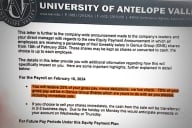You have /5 articles left.
Sign up for a free account or log in.
NEW YORK – Sometimes at odds with one another, the for-profit and nonprofit sectors of higher education had something of a meeting of the minds here Friday.
Moderating a panel for the TIAA-CREF Institute's 2010 Higher Education Leadership Conference, Guilford College President Kent Chabotar pressed two longtime higher education leaders to find areas where the two sectors could learn from one another. Among the participants was Peter Smith, vice president of academic strategies and development for Kaplan Higher Education, who said faculty at nonprofits need to embrace the data-driven assessments of teaching and learning that are commonly used by for-profit institutions.
Professors can view rigorous assessment as something of an invasion of privacy, but such resistance prevents real reforms, Smith argued.
“When [resistance] conflicts with creating a successful learning environment, then you've got a problem,” Smith said.
Smith brings the perspective of a person who has worked on both sides of the industry. While currently an executive with a for-profit group of institutions, he previously served as founding president for California State University at Monterey Bay.
Carol Twigg, president and chief executive officer for the National Center for Academic Transformation, agreed that for-profits often do a better job of using data to assess effectiveness.
“Because they are driven by profit, I think they are much more attentive to that than traditional institutions are,” she said.
Twigg should know. Through her program, she has pressed colleges – often with some resistance – to drill down into data in order to learn what’s working and not working. The solution to a range of fiscal and educational problems, in Twigg’s view, is for colleges to implement more sophisticated uses of technology to improve outcomes and cut costs – often by growing class sizes dramatically and changing instructional methods.
The tension surrounding for-profit education in the United States tended to underpin several discussions at last week’s conference, although there was little overt mention of recent Congressional scrutiny of the sector or a push for strengthened regulations by the U.S. Department of Education.
Sen. Tom Harkin (D-Iowa), chairman of the Health, Education, Labor and Pensions Committee, has focused intently on what he describes as the bad actors among proprietary institutions, where there’s some evidence that students have been deceived about the true costs of attendance and their likely employment prospects upon completion of programs.
While panelists at TIAA-CREF mostly dodged or ignored the inner-Beltway debate, a noted news personality gave her two cents. Speaking at a post-conference dinner in the aristocratic confines of the University Club, Cokie Roberts, senior news analyst at NPR, predicted that Democratic lawmakers, in particular, will be reluctant to take on a sector with such clear ties to one of the nation’s most powerful newspapers. The Washington Post Co., which owns the newspaper, also owns Kaplan University, among other for-profits.
“But I have to tell you, the biggest objection to [regulation] has come from the fact that The Washington Post would go out of business if Kaplan went out of business – yes, I see Peter Smith waving,” Roberts said with a chuckle. “Because The Washington Post money all comes from Kaplan and the Democrats don’t want The Washington Post to go out of business, so I think there are a lot of forces militating against those rules at the moment.”
While the Post maintains the independence of its newsroom, its editorial page has argued against new rules proposed by the U.S. Department of Education.
There is little question that for-profit colleges play an increasing role in American higher education, and some argue the institutions will be crucial in helping the U.S. improve college attainment in service to goals laid out by President Barack Obama. For-profit colleges receive about a quarter of all Pell Grant and federal aid, according to the Federal Student Aid Data Center. These institutions enrolled 3.2 million students, or 11.8 percent of the 27.4 million students in the postsecondary population, during the 2008-09 academic year, according to the Education Department.
When for-profits get praise, it’s often because many of those institutions have a record of providing flexible course offerings to working adults for whom traditional educational models just don’t work. There is too great a tendency across higher education, Twigg argued, to limit student options in the same way a bad restaurant might offer just one menu item.
“You get roast beef, mashed potatoes and peas,” she said, when “even though you're a vegetarian, you're allergic to peas.”









